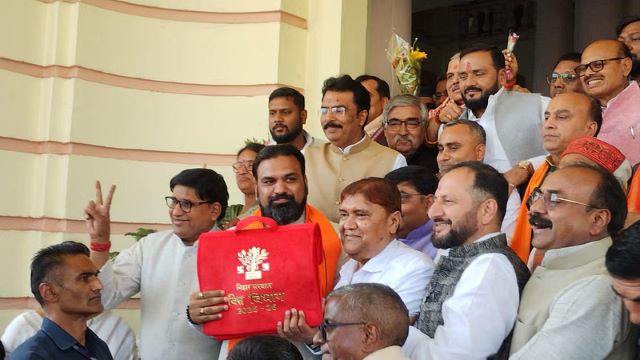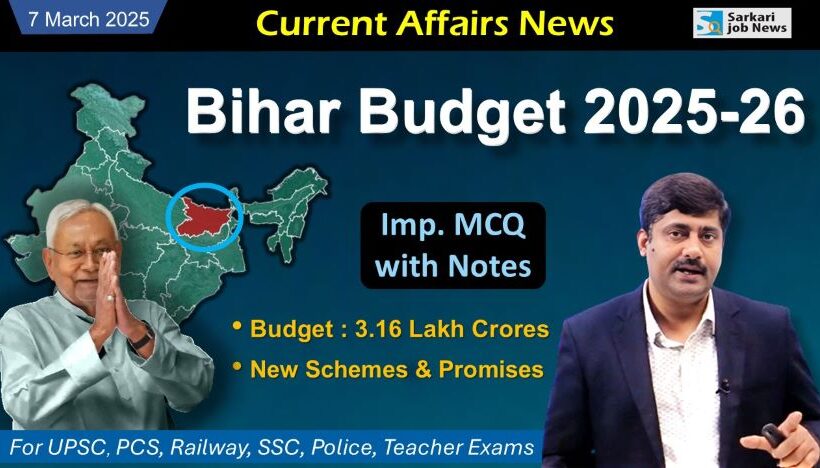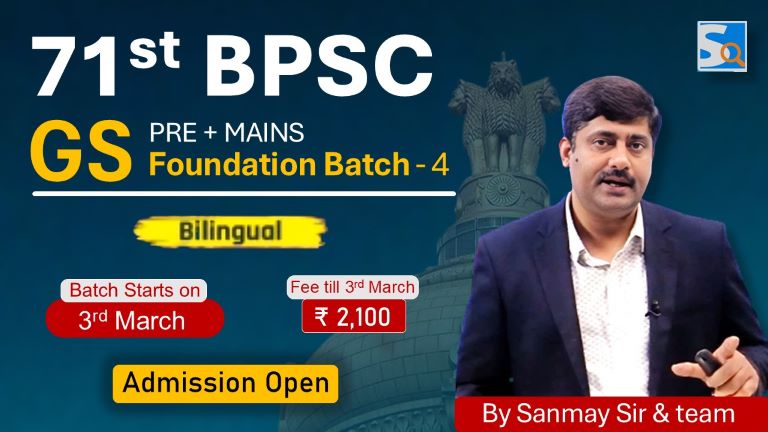This is the current affairs of 7 March 2025. Here are questions and answers of daily current affairs for better preparation of competitive exams for government jobs.
PDF Download: Click here
1. In the budget 2025-26, the Bihar government has set a target of spending how many rupees?
a. Rs 2.37 lakh crore
b. Rs 2.78 lakh crore
c. Rs 3.08 lakh crore
d. Rs 3.16 lakh crore
Answer: d. Rs 3.16 lakh crore (3,16,895.02 crore)

– The Deputy Chief Minister of Bihar, Samrat Chowdhury, presented the budget for the state’s financial year 2025-26 on March 3, 2025.
– The Chief Minister of Bihar is Nitish Kumar.
– Budget for the financial year 2025-26: 3.16 lakh crore rupees (3,16,895.02 crore)
– Budget for the previous financial year 2024-25: 2.78 lakh crore rupees
– Difference compared to the previous budget: 38,169 crore
Income target in the budget: 3.17 lakh crore (3,17,094.63 crore)
– Revenue receipts: 2.60 lakh crore
– Capital receipts: 56,263 crore (This includes 55,737 crore as new loans and 525 crore as loan recovery)
(Revenue receipts: Earnings from taxes, the state’s revenue structure; Capital receipts: Loan recovery and new borrowing)
Income details:
– Share of central taxes for the state: 43.68%
– State government tax revenue: 18.77%
– Public debt: 17.58%
– Grants from the central government: 17.21%
– Other state tax revenue: 2.59%
– Loan recovery: 0.17%
—-
Expenditure target in the budget: 3.16 lakh crore (3,16,895.02 crore)
– Revenue expenditure: 2,52,000 crore
– Capital expenditure: 64,894 crore
Note:
– Revenue expenditure: Salaries and schemes
– Capital expenditure: New construction, work that will remain as long-term capital.
Note – The expenditure can also be broken down as follows:
– Scheme expenditure: 1,16,759 crore
– Establishment and commitment expenditure: 2,00,135 crore
(Scheme expenditure: New schemes and infrastructure; Establishment and commitment expenditure: Salaries, some commitments, etc.)
Expenditure details:
– Social services: 39.80%
– General services: 28.94%
– Economic services: 23.58%
– Repayment of public debt: 7.20%
– Debt and pensions: 0.49%
– Auxiliary grants and contributions: 0.01%
—————
2. In Bihar Budget 2025-26, in which department or sector is there a provision for maximum expenditure?
a. Health
b. Education
c. Rural Development
d. Energy
Answer: b. Education (19.25% of total budget = Rs. 60,964 crore {including plan assistance of Rs. 22,700 crore})

—————-
3. Budget allocation to major items or departments of Bihar and percentage of total budget
Department, Total Allocation, Percentage of Total Budget
– Education Department: 60964 crores, 19.24%
– Pension: 33389 crores, 10.54%
– Interest Payment: 23013 crores, 7.26%
– Loan Repayments: 22819 crores, 7.20%
– Health Department: 20035 crores, 6.32%
– Home Department: 17831 crores, 5.63%
– Rural Development Department: 16093 crores, 5.08%
– Energy Department: 13484 crores, 4.26%
– Urban Development and Housing Department: 11982 crores, 3.78%
– Panchayati Raj Department: 11302 crores, 3.57%
– Rural Works Department: 8789 crores, 3.50%
– Social Welfare Department: 8774 crore, 2.77%
– Water Resources Department: 7451 crore, 2.35%
– Building Construction Department: 6894 crore, 2.18%
– Road Construction Department: 6806 crore, 2.15%
– Disaster Management Department: 4967 crore, 1.57%
– Finance Department: 3646 crore, 1.15%
– Agriculture Department: 3528 crore, 1.11%
– Public Health Engineering Department: 2702 crore, 0.85%
– Planning and Development Department: 2602 crore, 0.82%
– Industry Department: 1966 crore, 0.62%
– Revenue and Land Reforms Department: 1955 crore, 0.62%
– Scheduled Caste and Scheduled Tribe Welfare: 1935 crore, 0.61%
– Minor Water Resources Department: 1839 crores, 0.58%
– Backward Classes and Extremely Backward Classes Welfare: 1787 crores, 0.56%
– Animal and Fisheries Resources Department: 1781 crores, 0.56%
– Law Department: 1681 crores, 0.53%
– Food and Consumer Protection: 1317 crores, 0.42%
– General Administration Department: 1254 crores, 0.40%
– Cooperative Department: 1231 crores, 0.39%
– Labor Resources Department: 1231 crores, 0.39%
– Election Department: 1189 crores, 0.38%
– Science Technology and Technical Education Department: 1159 crores, 0.37%
– Tourism Department: 1103 crores, 0.35
– Environment Forest and Climate Change Department: 906 crores, 0.29%
– Minority Welfare Department: 870 crores, 0.17%
– Liquor Prohibition, Excise and Registration Department: 692 crores, 0.22%
– Cabinet Secretariat Department: 548 crores, 0.17%
– Transport Department: 530 crores, 0.17%
– High Court: 326 crores, 0.10%
– Legislature: 314 crores, 0.10%
– Information Technology Department: 289 crores, 0.09%
– Information and Public Relations Department: 283 crores, 0.09%
– Commercial Tax Department: 277.74 crores, 0.09%
– Art, Culture and Youth Department: 277 crores, 0.09%
– Sports Department: 248 crores, 0.08%
– Sugarcane Industry Department: 192 crores, 0.06%
– Bihar Public Service Commission: 112 crores, 0.04%
– Mines and Geology Department: 77.46 crores, 0.02%
– Governor’s Secretariat: 58.23 crores, 0.02%
– Monitoring Department: 48.67 crores, 0.02%
– Parliamentary Affairs Department: 10.71 crores, 0.001
= Grand Total: 3,16,895 crores: 100%
—————
4. What is the estimated state Gross State Domestic Product (GSDP) on the basis of current prices in the financial year 2025-26 in the Bihar budget?
a. 9,45,565 crores
b. 8,54,429 crores
c. 7,46,417 crores
d. 10,97,264 crores
Answer: d. 10,97,264 crores (8,54,429 crores in the previous financial year 2024-25 and 7,46,417 crores in 2023-24)
Estimation of Gross State Domestic Product (GSDP) at Current Prices:
– Financial year 2025-26: 10,97,264 crore
– Financial year 2024-25: 8,54,429 crore
– Financial year 2023-24: 7,46,417 crore
What is Gross State Domestic Product (GSDP)?
– GDP is the total value of all goods and services produced within a country during a specific period. It is the most common way to measure the economic size of a country.
– Similarly, the total value of all goods and services produced in a state during a financial year is called GSDP. It serves as a measure of the state’s economic size.
————–
5. Bihar government has set the target of state’s fiscal deficit as what percent of GSDP in the budget 2025-26?
a. 0.47%
b. 1.98%
c. 2.47%
d. 2.98%
Answer: d. 2.98% [Rs. 32,718 crores] (same percentage in previous financial year also)
– The Gross State Domestic Product (GSDP) of Bihar is estimated to be 10.97 lakh crore at current prices.
– The fiscal deficit is estimated to be 2.98% of GSDP (32,718 crore rupees).
– This is below the 3% debt ceiling set by the central government.
Fiscal Deficit = Total Non Debt Expenditure- Total Non Debt Receipts
– Total Non Debt Expenditure means total expenditure without debt
– Total Non Debt Receipts means Revenue Receipts and Capital Receipts without debt
– The amount remaining after subtracting revenue receipts, loan recoveries, and loan repayments (Total Non-Debt Receipts) from the total expenditure is called the fiscal deficit.
What are the consequences of a fiscal deficit?
– When governments spend more or offer tax concessions, there is a concern that this will force them to borrow more money.
– When governments borrow more, they either leave less money for private individuals and companies to borrow, which in turn raises interest rates for everyone. Or, they may be forced to print money – which leads to inflation, functioning like a tax because it reduces people’s purchasing power.
—————
6. According to Bihar Budget 2025-26, how much public debt does the state have as of March 31, 2025?
a. 2,97,908 crore
b. 1,97,908 crore
c. 97,908 crore
d. 3,32,740 crore
Answer: d. 3,32,740 crore
– The outstanding public debt is estimated to be 3,32,740 crore rupees by March 31, 2025, which is 38.94% of the GSDP (10,97,264 crore) at current prices.
—————
7. How much amount did the Bihar government provision for the Seven Nischay-2 schemes in the Budget 2025-26?
a. Rs 2,040 crore
b. Rs 5,972 crore
c. Rs 8,040 crore
d. Rs 15,040 crore
Answer: b. Rs 5,972 crore
7 Determinations of Bihar Government-2
1. Youth power-Progress of Bihar
2. Empowered women- Capable women
3. Clean village- Prosperous village
4. Easy connectivity
5. Additional health facility for all
6. Clean city- Developed city
7. Irrigation water to every farm
————–
8. Employment and jobs
– Chief Minister Nitish Kumar has said that 50 lakh youth will be given employment and jobs in 2025-26.
– Out of these, 12 lakh will get government jobs and 38 lakh will get employment.
————–
9. What new policies did the Bihar government announce in Budget 2025-26?
a. Bihar Industrial Disinvestment Promotion Policy and Bihar Biofuels Production Promotion (Amendment) Policy
b. Bihar Food Processing Policy and Bihar Pharmaceutical Promotion Policy
c. Bihar Plastic Manufacturing Promotion Policy
d. All of the above
Answer: d. All of the above
Five policies announced
1) Bihar Industrial Disinvestment Promotion Policy, 2025
2) Bihar Biofuels Production Promotion (Amendment) Policy, 2025
3) Bihar Food Processing Policy, 2025
4) Bihar Pharmaceutical Promotion Policy, 2025
5) Bihar Plastic Manufacturing Promotion Policy, 2025
————–
10. Announcements in Bihar Budget 2025-26
1) Modernization of 21 agricultural produce markets
2) Purchase of tur, moong, urad etc. will be done by fixing minimum support price (MSP).
3) Cold storage will be established in sub-divisions and all blocks.
4) On the lines of ‘Sudha’, ‘Tarkari Sudha’ outlets will be jointly established in all blocks.
5) Kanya Vivah Mandap in all panchayats.
6) Mahila Haat in Patna.
7) There will be Gym on Wheels in Patna, the trainers will be only women.
8) Pink toilets for women in all cities.
9) Modernization of bus stands in all districts.
10) A ‘Centre of Excellence’ in Pusa (Samastipur) for jaggery.
11) Migration Consulting cum Registration Centres will be established in selected cities of the country. These cities are Hyderabad, Bengaluru, Mumbai, Delhi NCR, Kolkata, Guwahati, Surat, Ludhiana, Coimbatore and Chennai.
12) There are a total of 534 blocks in the state, out of which affiliated/government degree colleges will be established in 358 blocks. There were no degree colleges in these blocks.
13) New private medical colleges
14) New government medical colleges will be opened under Public Private Partnership (PPP).
15) Bihar Cancer Hospital will be established.
16) Sports infrastructure on 100 acres in Punpun block of Patna division
17) One outdoor stadium in every block
18) Phase-2 plan was made to increase the computing storage capacity of State Data Center 2.0. More than 500 websites and apps will be able to be hosted through this. 19) Pink bus service for women in major cities. The passengers, driver and conductor will be women.
20) 33 percent reservation for women in the posts of driver, conductor and depot maintenance staff in Bihar State Road Transport Corporation.
21) Cash grant for e-rickshaw and two-wheeler for women drivers for women self-employment.
22) Solar power plants will be installed on vacant spaces along the canals and dams.
23) Announcement of Bihar Green Development Fund, an investment of 25 crores will be made in it. So that it helps in making Bihar climate-friendly and carbon-neutral.
24) Religious tourism scheme will be started on Chhath Puja. Home stays will be encouraged.
25) Women will be trained as tourist guides.
26) Purnia airport is being constructed, it will be operational soon. 27) Airports will be built in Rajgir, Sultanganj (Bhagalpur) and Raxaul.
28) Small airports will be built in Bhagalpur, Valmikinagar, Veerpur (Supaul), Madhubani, Munger.
29) Muzaffarpur Airport will be developed under the Airport Udaan Yojana. Small aircraft with a capacity of up to 19 seats will operate here.
30) Integrated Center of Bihar will be established in major metro cities of the country. It will promote Bihar’s traditional crafts, handicrafts, folk arts, food dishes, investment.
31) To reduce the risk of weather-related disasters, a hybrid Doppler weather radar network will be built in West Champaran and Bhagalpur under the Multi Hazard Early Warning System.
32) All registration offices will be made completely paperless. People living in the country or outside the country will also be able to register online.
33) Capital Patna will be connected to all the district headquarters by a 4-lane road.
————–
11. According to Bihar Budget 2025-26, what was the per capita income of the state in 2023-24?
a. 59,244
b. 66,828
c. 77,526
d. 98,550
Answer: b. 66,828
– Per capita income in financial year 2023-24: Rs 66,828
– Per capita income in financial year 2022-23: Rs 59,244
————–
12. According to Bihar Economic Survey 2024-25, what was the state’s Gross State Domestic Product (GSDP) growth rate at current prices in the financial year 2023-24?
a. 13.5%
b. 14.5%
c. 15.5%
d. 16.5%
Answer: b. 14.5% (at current prices) [9.2% (at constant prices)]
– Bihar is one of the states consistently achieving high economic growth rate.
– Gross State Domestic Product (GSDP) of Bihar in the financial year 2023-24 is estimated at Rs. 8,54,429 crore at current prices and Rs. 4,64,540 crore at 2011-12 constant prices.
– GSDP is estimated to grow by 14.5% (at current prices) and 9.2% (at constant prices) in the financial year 2023-24.
————–
13. Important facts of Bihar Economic Survey
– The Bihar Economic Survey 2024-25 was presented by the state’s Deputy Chief Minister Samrat Choudhary in the Legislative Assembly on February 28, 2025.
– This is the 19th Economic Survey of the state. It provides information about the status of Bihar’s economy and its development.
Economic Growth Rate:
– Bihar ranks second among the fastest-growing states in the country.
– In the financial year 2023-24, Bihar’s Gross State Domestic Product (GSDP) is estimated to be 8,54,429 crore rupees at current prices and 4,64,540 crore rupees at 2011-12 constant prices.
– The GSDP growth rate in the financial year 2023-24 is 14.5% (at current prices) and 9.2% (at constant prices).
– In the financial year 2023-24, the per capita income is estimated to be 36,333 rupees at constant prices and 66,828 rupees at current prices, which is higher than the previous year.
– Patna is the richest district in Bihar, and Shivhar is the poorest district.
Fiscal Deficit:
– The fiscal deficit for the financial year 2022-23 was 44,823 crore rupees, which decreased to 35,660 crore rupees in the financial year 2023-24.
– The fiscal deficit is expected to be 29,095 crore rupees in the financial year 2024-25.
– The revenue surplus for the financial year 2023-24 was 2,833 crore rupees, while it is expected to be 1,121 crore rupees in the financial year 2024-25.
– The total expenditure of the state for the financial year 2023-24 was 2.52 lakh crore rupees, and it is expected to increase to 2.79 lakh crore rupees in the financial year 2024-25.
– Development expenditure is expected to increase from 1.69 lakh crore rupees to 1.77 lakh crore rupees.
Environment and Climate Change:
– Efforts to tackle climate change have been made by implementing schemes like the Green Budget and Jal-Jeevan-Hariyali Mission.
– In the state, the forest area has increased by 687 square kilometers over 12 years.
Agriculture and Industrial Sector:
– Rice production has increased by 21%, and wheat production has increased by 10.7%.
– Livestock and fisheries have grown at a rate of 9.50%.
– The Bihar government is implementing an Agricultural Investment Promotion Policy for seven products. These products are fox nut (Makhana), fruits, vegetables, maize, medicinal plants, honey, and tea.
– An investment of 75,293.76 crore rupees is proposed in Bihar’s industrial sector.
– The services sector (tertiary sector) remains the largest contributor to Bihar’s Gross State Domestic Product (GSDP), contributing 58.6%, followed by industry (secondary sector) at 21.5%, and agriculture (primary sector) at 19.9%.
– Investment in micro enterprises has increased by 135%, and employment has increased by 107%. – Similarly, investment in large-scale units has increased by 131%, leading to a 187% increase in employment opportunities.
– Additionally, a 9% growth has been recorded in Bihar’s mining sector.
Roads and Infrastructure:
– The length of rural paved roads has increased from 835 km in 2005 to 1.17 lakh km in 2025.
– The construction of new expressways and national highways is expanding the transportation system in the state.
– Between 2011 and 2024, Bihar recorded the third-highest growth in the transportation and communication sector, at 7.6%, following Uttar Pradesh (10.1%) and Karnataka (7.7%).
– Bihar’s road density is 3167 per thousand square kilometers. In terms of road density, it ranks third.
Digital Governance and Energy Sector:
– The government has promoted e-governance by adopting technologies like CCTNS, CFMS, Cyber Cell, and e-Challan.
– Per capita energy consumption will increase from 134 kWh (2012-13) to 363 kWh (2023-24).
– The top five districts in electricity consumption are Patna, Gaya, Muzaffarpur, Rohtas, and Nalanda.
– There has been a 14.5% increase in public utility services such as water supply, electricity, and gas connections.
Women Empowerment:
– 1,063.5 thousand Self-Help Groups (SHGs) have been formed.
– 2,198.4 thousand SHGs have been provided cumulative loans of 46.9 thousand crore rupees to promote women empowerment.
– By the financial year 2024-25, the total deposit amount was 5.27 lakh crore rupees, of which 2.97 lakh crore rupees were distributed as loans, with a loan-deposit ratio of 56.3%.
– From the financial year 2022-23 to 2023-24, there has been an improvement in women’s labor force participation rate. In rural areas, the rate has increased from 24.8% to 33.5%, and in urban areas, it has increased from 13.8% to 18%.
– The labor force participation ratio of men and women in Bihar is lower than the overall national average.
Education and Health Sector:
– Over the past 18 years, expenditure on education has increased tenfold, health expenditure has increased thirteenfold, and social services expenditure has also increased thirteenfold.
– The child welfare budget was introduced in 2013-14, and it has grown at an annual rate of 19.4% between 2016-23.
– The dropout rate in government secondary schools has decreased by 62.25% over the past five years.




